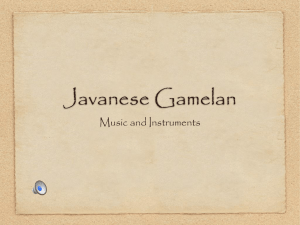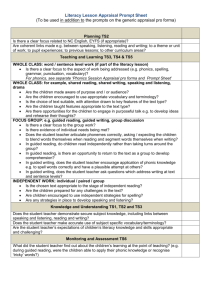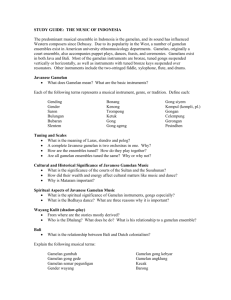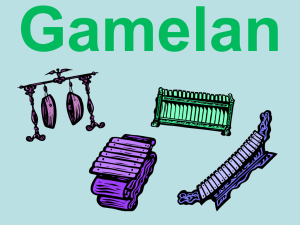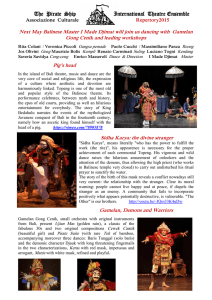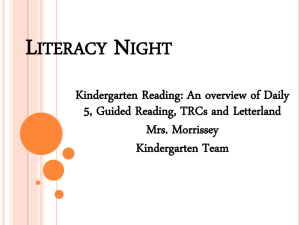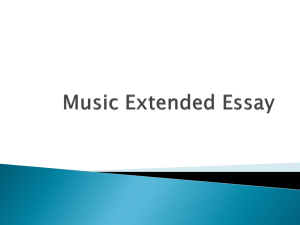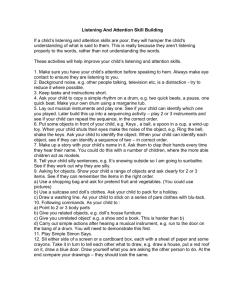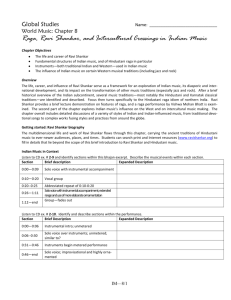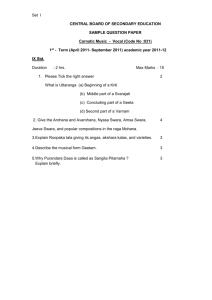Exam_2_study_guide
advertisement
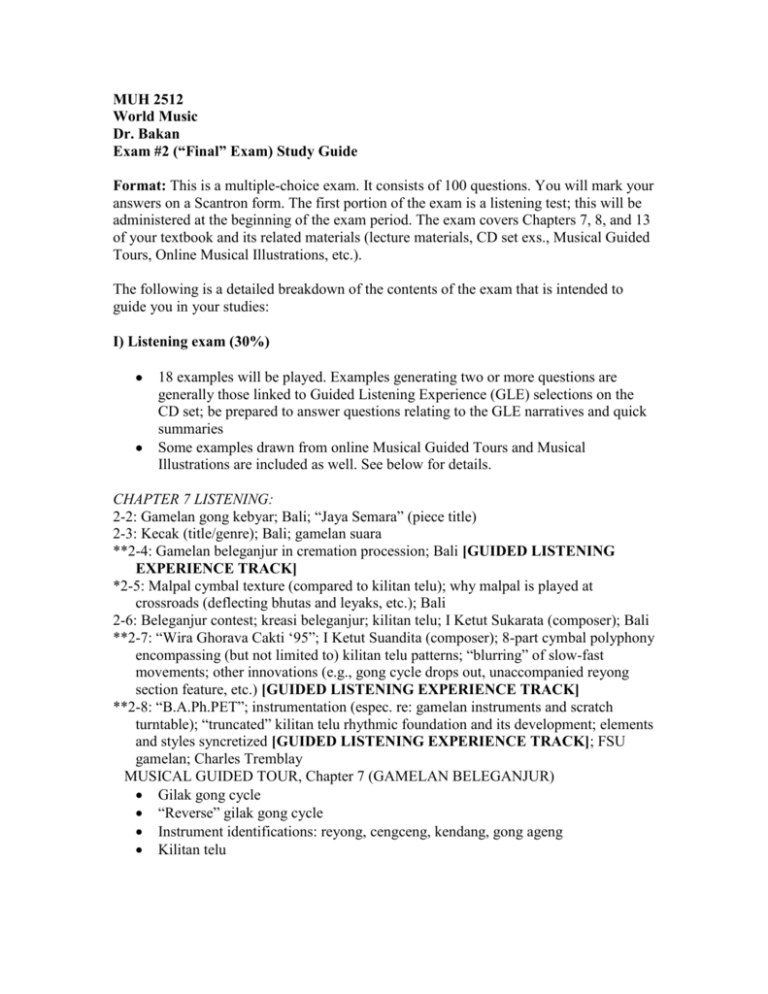
MUH 2512 World Music Dr. Bakan Exam #2 (“Final” Exam) Study Guide Format: This is a multiple-choice exam. It consists of 100 questions. You will mark your answers on a Scantron form. The first portion of the exam is a listening test; this will be administered at the beginning of the exam period. The exam covers Chapters 7, 8, and 13 of your textbook and its related materials (lecture materials, CD set exs., Musical Guided Tours, Online Musical Illustrations, etc.). The following is a detailed breakdown of the contents of the exam that is intended to guide you in your studies: I) Listening exam (30%) 18 examples will be played. Examples generating two or more questions are generally those linked to Guided Listening Experience (GLE) selections on the CD set; be prepared to answer questions relating to the GLE narratives and quick summaries Some examples drawn from online Musical Guided Tours and Musical Illustrations are included as well. See below for details. CHAPTER 7 LISTENING: 2-2: Gamelan gong kebyar; Bali; “Jaya Semara” (piece title) 2-3: Kecak (title/genre); Bali; gamelan suara **2-4: Gamelan beleganjur in cremation procession; Bali [GUIDED LISTENING EXPERIENCE TRACK] *2-5: Malpal cymbal texture (compared to kilitan telu); why malpal is played at crossroads (deflecting bhutas and leyaks, etc.); Bali 2-6: Beleganjur contest; kreasi beleganjur; kilitan telu; I Ketut Sukarata (composer); Bali **2-7: “Wira Ghorava Cakti ‘95”; I Ketut Suandita (composer); 8-part cymbal polyphony encompassing (but not limited to) kilitan telu patterns; “blurring” of slow-fast movements; other innovations (e.g., gong cycle drops out, unaccompanied reyong section feature, etc.) [GUIDED LISTENING EXPERIENCE TRACK] **2-8: “B.A.Ph.PET”; instrumentation (espec. re: gamelan instruments and scratch turntable); “truncated” kilitan telu rhythmic foundation and its development; elements and styles syncretized [GUIDED LISTENING EXPERIENCE TRACK]; FSU gamelan; Charles Tremblay MUSICAL GUIDED TOUR, Chapter 7 (GAMELAN BELEGANJUR) Gilak gong cycle “Reverse” gilak gong cycle Instrument identifications: reyong, cengceng, kendang, gong ageng Kilitan telu CHAPTER 8 LISTENING: 2-9: Bhajan; India 2-10: Sufi song; Punjab (India/Pakistan); Shafqat Ali Khan 2-11: MUSICAL GUIDED TOUR, CHAPTER 8: “An Introduction to Indian Music” (Ravi Shankar) Instruments: sitar, tabla, tambura Alap Tintal (16 beat tala) vs. jhaptal (10 beat tala) Tihai (define; number of times basic pattern repeated) **2-12: Raga Nat Bhairav; Hindustani raga; morning raga; basic “scale” of the raga; note-by-note development of the alap; alap vs. gat; instruments (modified guitar [Mohan vina], tabla, tambura) [GUIDED LISTENING EXPERIENCE TRACK] 2-13: John Coltrane; soprano saxophone; 1961; “India” **2-14: Shakti; John McLaughlin, Zakir Hussain, L. Shankar; complex tala cycle; JM’s modified guitar; raga elements in this Indian-jazz fusion [GUIDED LISTENING EXPERIENCE TRACK] **2-15: Trilok Gurtu; “Living Magic”; “Alap” vs. “Gat”-like sections; vina “alap” w. electronic processing [GUIDED LISTENING EXPERIENCE TRACK] CHAPTER 13 LISTENING: MUSICAL GUIDED TOUR, CHAPTER 13: Identify ornaments; identify Henan vs. Shandong regional style on basis of vibrato 3-20: qin (type of instrument, number of strings) **3-23: title, baban form, type of zheng (16 strings with steel strings), playing technique [GUIDED LISTENING EXPERIENCE TRACK] 3-25: departure from baban form as innovation; programmaticism; accelerating, ostinato-based form in last part of piece **3-27: title of piece, composer (Fan Shang’e), playing techniques employed, form (not baban), “Tibetan” source materials [GUIDED LISTENING EXPERIENCE TRACK] 3-28: Tibetan Buddhist chant, voice multiphonics **3-30: Uighur music and culture influences, Uighur muqam influence (re: instrumentation, musical scale/mode, etc.), Uighur attitudes toward cultural appropriation in Chinese pieces of this type [GUIDED LISTENING EXPERIENCE TRACK] II) Multiple choice questions (70%)* *[There 23-24 questions each drawn from Chs. 7, 8, and 13, respectively] Chapter 7 (Indonesian music) GENERAL: Use assigned readings, CD exs., key terms lists/study questions/discussion questions at end of chapter, Blackboard-posted lecture notes and film viewing notes (Bali: Masterpiece of the Gods; Raga: Ravi Shankar), and study resources at Online Learning Center to prepare. SPECIFIC: o Cities (including capitals of Indonesia and of Bali), islands in Indonesia discussed in text, lectures (see chapter map) o Debussy and gamelan o Religion in Indonesia, religion in Bali o Agama Tirta o General musical comparison, Balinese and Javanese gamelan (kebyar vs. C. Javanese court gamelan) o Gamelan gong kebyar (meaning of the words, types of instruments) o Paired tuning, ombak o Types of gamelan discussed (gong kebyar, beleganjur, suara, Central Javanese court gamelan o Important instruments: gangsa, gong ageng, reyong, cengceng o Gilak gong cycle, kilitan telu interlocking cymbal patterns o Kecak (music, history, dance-drama, gamelan suara) o Gamelan beleganjur: traditional (cremation processions, spinning of the tower, drummer as leader, positioning of beleganjur ensemble in procession), kreasi (contests), major composers (Sukarata, Asnawa, Suandita) and associated pieces; commonalities and distinctions between traditional and kreasi styles o Bali Aga culture and religion o Kebyarization, classicization in belganjur o Gerak o “Wira Ghorava Cakti” (CD 2-6) innovative features (composer: Suandita) o Musical Guided Tour (type of ensemble focused on, instruments, kilitan telu, gilak gong cycle) o “Kekembangan” piece (Ziporyn, Windha—gamelan and saxophone quartet) o Double concerto for violin and cello with gamelan, by Lou Harrison o “B.A.Ph.PET,” by M. Bakan Chapter 8 (Indian music) GENERAL: Use assigned readings, CD exs., key terms lists/study questions/discussion questions at end of chapter, Blackboard-posted lecture notes and film viewing notes (Raga: Ravi Shankar), and study resources at Online Learning Center to prepare. SPECIFIC: o Qawwali (Punjab, Nusrat Fateh Ali Khan) o Hindustani vs. Karnatak traditions (instruments, religion, cultural aspects, similarities and differences, histories) o Barhat o Gharana o Vedic chant (and its debatable relationship to Hindustani classical music traditions) o Bhajan o Sufism o Melody, drone, rhythmic accompaniment: texture, associated instruments o Ravi Shankar, Baba (Allaudin Khan), Ali Akbar Khan, Vishwa Mohan Bhatt, Alla Rakha, Zakir Hussain, Yehudi Menuhin, John Coltrane, John McLaughlin and Shakti, Trilok Gurtu, George Harrison o Sitar, tabla, tambura (construction, features) o Other Indian melodic instruments o Defining characteristics of a raga o Raga form (alap, gat); also re: barhat (growth), musical-social interaction, etc. o Raga Nat Bhairav (characteristics of the raga, questions about the Vishwa Mohan Bhatt performance of it) o Beatles, “great sitar explosion”—“Norwegian Wood,” “Within You, Without You” o Tala (features of, tintal) o Shakti’s “Joy,” Gurtu’s “Living Magic,” Bhatt’s “Raga Nat Bhairav,” “An Intro to Indian Music” MGT Chapter 13 Questions (Chinese music) Instruments: zheng (various types, history, performers, compositions, etc.), other East Asian board zither chordophones (koto, kayagum, jatag, dan tranh), pipa, erhu, qin, sheng Basic facts: Han majority, Mandarin language, “ethnic minorities” (Uighur, Tibetan), major cities (largest, capital, etc.), conservatories, main historical periods discussed in chapter (imperial dynasties [espec. Han and Tang], Republican, initial communist, Cultural Revolution, Period of Openness), important dates Etymology of zheng (i.e., according to the legend of the two imperial sisters in Qin era who broke an instrument in a dispute [Chinese word for which is “zheng”]) Yijing, yun, baban form Gua-zou (glissandos) and other melodic ornaments discussed in Musical Guided Tour Confucianism re: music; Confucianism re: during what dynasty it became basis of Chinese social order (hint: NOT during Confucius’s lifetime) Politics and music relationship historically Innovative, distinctive features of main pieces discussed (“Autumn Moon over the Han Palace,” “Return of the Fishing Boats,” “Spring on Snowy Mountains,” “Music from the Muqam” Deng Xiaoping’s statement on policy of the arts (long block quote) Tiananmen Square uprising, Cui Jian Musical reform movements (re: Western music, Chinese music, Liu Tianhua, etc.) Female performers and the zheng in modern times and historically Deng Haiqiong, Tan Dun, Yo-Yo Ma, Cui Jian, Fan Shang’e, Liu Tianhua, Lou Shuhua Tensions in relationship of Chinese government and “ethnic minorities” (Uighur, Tibetan)
